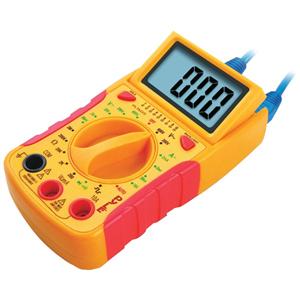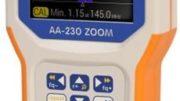Your average person might not need a multimeter. Of course, you, my fine Solid Signal Blog reader, is far above average. You’re the cream of the tech crop, the bleeding edge of technological do-it-yourself-ness. While everyone else is satisfied with the idea of just taking what they have, you want to make it better. You’re always thinking of how to get the extra edge out of your technology. And that’s why you need a multimeter.
What is a multimeter?
In case you’ve never seen one, a multimeter measures voltage, amperage, and resistance. It’s a versatile test instrument that helps you figure out whether current is flowing, where it’s flowing to, and how much is flowing. It’s essential for testing circuits of any kind.
The big knob on the front shows you what you’re testing. Generally you can test at one of several different scales depending on what you need to know. You may want to know how many tenths of a volt are being provided to sensitive electronics, or how many hundred volts are going through a main circuit. A multimeter shows you both.
What can the average DIYer do with a multimeter?
First of all a multimeter is the world’s best battery tester. I don’t know about you but I’m pretty obsessive with batteries. If a device will take a rechargeable one I’ll use that. If it can’t, I try to use the right kind of battery. High-drain electronics get those expensive lithium batteries. Whenever possible, I test them when they stop working in my high-end stuff, and if there is still voltage coming from them I move them to something less taxing. In order to get more use out of my batteries, I test them with a multimeter.
Second of all, a multimeter can tell you where in any electric device the problem lies. Just keep testing for voltage and when you don’t find any, there’s where you need to look. You can also look at the voltage and amperage ratings of anything like a motor or power supply and if you’re not seeing the right numbers going in (to the motor) or going out (from the power supply) again you know you have a problem.
I use a multimeter to test coaxial cables two ways. Most multimeters have a continuity tester. It will test whether there is any sort of flow at all between two points. If there is, you’ll get a beep. You can use this to test coaxial cables. There should be continuity between the center conductor on one end and the center conductor on the other end, but not between the outer connector on either end and the center conductor on either end. If there is, that cable won’t work.
Here’s what I don’t do with a multimeter
You should be able to use a multimeter to test an outlet and see what voltage it’s putting out. I’ve seen electricians do and it’s probably safe. But, I don’t recommend putting anything but an electrical plug into any outlet. If you want to know if it’s hot, buy one of those cheap outlet testers at a home store. They’ll tell you everything you need to know and you’re a lot safer.
Why is there such a big difference in price in multimeters?
Generally a more expensive multimeter will either be able to measure smaller amounts of current, or will be able to measure more finely. The most expensive multimeters are very, very precise. More expensive meters are also more durable. They can take a fall from atop a telephone pole. You probably don’t need that level of protection, so don’t pay for it. But if you do, Solid Signal has those high priced meters alongside the others.
Check out the great selection of multimeters now at Solid Signal!





